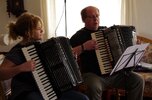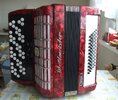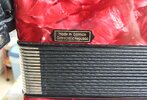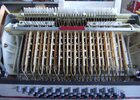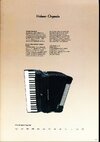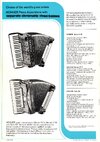Bernnt
Registrierter Benutzer
- Zuletzt hier
- 27.12.25
- Registriert
- 03.02.17
- Beiträge
- 3.377
- Kekse
- 14.297
Dieser Name hilft weiter. Du hattest wieder einen richtig guten Riecher. Mit dem Namen fand ich einen Artikel, der sich mit der Herkunft des Namens "Bayan" für die russischen Akkordeonmodelle befasst. Er findet sich hier:Sterligov
http://www.strumentiemusica.com/en/highlights/the-history-of-accordions-name-bayan/
In diesem Artikel erklärt ein Mann namens Alexander Selivanov unter anderem die Entwicklung der russischen Akkordeonmodelle:
"In our “History of accordion performance” books in USSR and Russia we can usually read the official version that in 1907 well-known accordion maker Piotr Sterligov had made the instrument for Jacov Orlansky-Titarenko – popular harmonica’s player from St Petersburg. This instrument was called “BAYAN”. J. Orlansky-Titarenko had numerous concerts with this and other new instrument made by Sterligov and contributed to great promotion of this name “Bayan” and also the type of these instruments everywhere in Russia. Soon all harmonics with the same construction were called “Bayan”. It was a type of harmonica with chromatic scale with 3, 4 or 5 rows of buttons in right hand.1 how we pronounce – «Garmon’» – was called only instruments with 1-2 rows and diatonic scale which used for popular tunes, easy folk melodies and so on.
Big Bayan “Yasnaya poliana” (TULA factory).3 rows in right, 64 buttons,E-la#4. 2 reeds in right. 4 in left. Full plates of reeds made in BRASS METALL. When multitembral 4 reeds bayans appeared in 50th-60th artisans started to use aluminum metal for reeds because of the lighter weight of aluminum. Convertor system of left hand means that this model produced in 60th or later when the education on free bass instruments started in all country.
In 70th Soviet players started to win classical categories in famous accordion competitions. And at that time the leaders of bayan art of USSR began to use new generation of bayan. It was already multitembral bayan with converter in left, cassotto and registers, 5th rows keyboards etc made by Soviet artisans special for these musicians. Now every professional musician knows about Jupiter, symbol of specific Russian sound, highest result of bayan evolution in USSR. Performers who started to play Jupiter (Moscow factory), Mir (Tula factory) and some other similar instruments have got the possibility to play transcriptions of classical music (including orchestral), contemporary music on new level of performance art."
[Auf deutsch: "In unseren Büchern über die 'Akkordeongeschichte' aus der UdSSR und Russland können wir gewöhnlich die offizielle Version lesen, dass 1907 der bekannte Akkordeonbauer Piotr Sterligov ein Instrument für Jacov Orlansky-Tatarenko machte, einen bekannten Akkordionisten aus St. Petersburg. Dieses Instrument nannte man 'Bayan'. J. Orlansky-Titarenko bestritt viele Konzerte mit diesem und einem anderen neuen Instrument, das von Sterligov gemacht wurde, und machte den Namen "Bayan" wie den Typ dieser Instrumente überall in Russland bekannt. Bald nannte man alle Harmonikas derselben Konstruktionsweise "Bayan". Es war ein Typ einer chromatischen Harmonika mit drei, vier oder fünf Reihen Knöpfen für die rechte Hand.
'Garmon' hingegen nannte man nur Instrumente mit ein oder zwei Reihen und einer diatonischen Tonleiter, welche man für populäre Stücke nutzte, einfache Volksmusik und so weiter.
'Große Bayan' “Yasnaya poliana” (TULA factory), 3 Reihen rechts, 64 Knöpfe, E-la#4. 2 Chöre rechts, vier links [sic!]. Die Stimmzungen machte man aus Messing. Als multitembrale vierchörige Bayane in den 50er-60er auf den Markt kamen, begannen die Hersteller, Aluminium für die Stimmzungen zu verwenden, weil Aluminium weniger wog. Ein Konvertersystem auf der linken Seite bedeutet, dass dieses Modell in den 60er Jahren oder später produziert wurde, als die Ausbildung auf Melodiebassinstrumenten überall im Land begann.
In den 70ern begannen sowjetische Spieler die klassischen Kategorien der berühmten Akkordeonwettbewerbe zu gewinnen. Und zu dieser Zeit begannen die Spitzenbayanisten der UdSSR eine neue Generation von Bayanen zu benutzen. Es handelte sich bereits um multitembrale Bayane mit Konverter links, Cassotto und Registern, 5 Reihen Knöpfe usw., die sowjetischen Instrumentenbauer speziell für diese Musiker machten. Nun kannte jeder Profimusiker Jupiter, ein Symbol typischen russischen Klangs, ein Spitzenresultat der Bayanentwicklung in der UdSSR. interpreten, die begannen Jupiter (Moskauer Fabrik), Mir (Fabrik in Tula) und einige andere ähnliche Instrumente zu spielen, hatten die Möglichkeit, Transkriptionen klassischer Musik (auch Orchestermusik), zeitgenössische Musik einzuspielen - und zwar auf einem neuen Level."]
Wie man diese Quelle zu bewerten hat, weiß ich nicht. Hat dieser Russe recht, der sich offensichtlich ziemlich gut über die Herstellung der Akkordeonmodelle in Russland auszukennen scheint, wurden auch erst in den 50er oder 60er Jahren Konverterinstrumente in Russland offiziell vertrieben. Herausragende Künstler wurden mit besonderen Instrumenten ausgestattet.
Welches Instrument Piotr Serligov aber Anfang des 20. Jahrhunderts baute, wird mir in diesem Text nicht recht klar. Auch der Wikipediaeintrag (https://de.wikipedia.org/wiki/Bajan), der die Geschichte auch kennt, hilft nicht weiter. Schaut euch den Originaltext meines ersten Links an. Auf jeden Fall wird man über diesen Namen Piotr Serligov bestimmt noch weiter kommen.
2006 führte Bruno Maurice ein Interview mit Françoise Jallot, einem Journalisten des französischen Akkordeonmagazins "Le magazine de l’Accordéon". In dem Interview (http://www.brunomaurice.com/appassionata/bayanengl.html) ging es um die Frage, was ein Bayan eigentlich ist. Es enthält eine detaillierte Schilderung der Baugeschichte:
"Russia is at the origin of a great impulsion in the development of accordion. In the middle of the XVII century, Johann Wilde already popularized the sheng (mouth organ, 3000 years before J.C) at the Court of St Petersburg. From 1770 to 1790, Kratzenstein, Kirsnik, and Vogler already worked on the elaboration of a free reeds instrument. Created in Austria in 1829 by Cyril Demian, the accordion achieved an immediate success. With a small size, packed in migrants’ luggage, he quickly conquered Europe and progressively the whole world. One year after its creation, it came to Russia at the Nijni-Novgorod Fair. Rebuilt and Russianized by Sizov, Tchouikov, Vorontsov and Emilianov, its production started in the city of Tula in 1830. Very popular, it took the name of “garmochka” and each region would create its own instrument. This is how were born the Khrômi, the tchérépachki, etc… At last, Bakanov, Beloborodov and Sterligov created an instrument with bass buttons and a keyboard (piano) for the right hand. The system, originally diatonic, (biresonant, with a tone when pulling and a tone when pushing), is abandoned for a chromatic system with two rows of buttons designed by N.I. Beloborodov in 1870. In 1883, P.I. Tchaïkowsky used four accordions in his Second Suite for symphonic orchestra. In 1907, in Ryazan, the accordion builder Sterligov and the accordion player Orlansky-Titarenko modernized the chromatic accordion: they created a unique model with four rows of buttons in the right side and left keyboard with six rows of free concords and basses. This type of accordion allows folk melodies as well as classical melodies. They will call this new instrument “bayan”. This word, inspired of the Russian legend of the Prince Igor (an evocation of the history of the ruthen principalities of the XIIth century telling the unfortunate expedition of Prince Igor), refers to “Boyan”, a poet, magician and troubadour that was singing historical and fantasy stories accompanying himself on his “Gouvsi” (a plucked stringed instrument).
In 1929, P.E Sterligov presented a new type of left keyboard: a system with a mechanic release. This new mecanique allows, just by pressing a button, to switch from the harmonic system with prepared concords (“standard basses”) to the chromatic keyboard system (one note per button, like on the right keyboard). This invention considerably improved the bayan performances.
Very soon, the bayan appeared in national folk music departments in the higher conservatories of Soviet Union: first in 1926 in St Petersburg, then in 1927 in Moscow and Kiev. After a recital performed by Gvozdev in St Petersburg in 1935, this chromatic accordion became a soloist instrument. Elevated in the thirties at the highest place within the concert instrument category, these composers started to write especially for the bayan. In 1937, at the St Petersburg Philarmony, Gvozdev plays the first concerto for bayan and symphonic orchestra written by Rubtsov and Sotnikov. In 1939, the first competition for bayan players in Soviet Union was born: the three prize winners were I. Panitsky, N. Rizol and M. Beletskaya. Among the great virtuosos of the time were Y. Orlansky-Titarenko, I.Gladkov, M.Makarov, A.Kuznetsov, Y.Popkov, I.Panitsky, I.Malinin and B.Tikhonov. After the Second World War, more and more concertists appeared. Their programs consisted of folk music as well as transcriptions from Borodine, Mussorgsky, Tchaikovsky, Stravinsky or even Prokofiev. Composers will at that time write for soloist bayan. : V. Zolotarev, A. Repnikov, S. Gubaidulina, A. Kusiakov, G. Shenderev, Y. Derbenko, V. Semyonov, S. Berinsky, … Well known soloists such as M. Gelis, N. Rizol, V. Gorokhov, A. Onegin, P. Gvozdev et N. Tchaikin gave the impetus to a new generation of musicians such as Y. Kazakov, A. Belyaev, E. Mitchenko, V. Galdin, Y. Vostrelov, A. Sklyarov, V.V. Besfamilnov, F. Lips, V. Semyonov, … From 1966, the Soviets start to take part in international competitions of accordion (particularly in Klingenthal, in former RDA). Armed with their technique, their instruments and their repertory, their apparition is the subject of a real revelation and a great influence on the Western musical world. Hence, the bayan becomes the instrumental model for the greatest virtuosos of accordion.
The bayan always had a very strong reputation in Soviet Union, it was respected by musicians and represented the instrument of the national identity. It melted national folk music and classical music. The image of the bayan as a mirror of Russian technology and of Russian culture abroad, was so important for the Soviet government that the accordion making factory Jupiter was included into the experimental department of the Red Army.
Since 1989, the year of the fall of the Berlin Wall, the secrets of bayan making and the Russian know how are shared with Western Europe who tried to forge bayans for a long time. Today, Italian instrument builders in Castlfidardo create bayan type models taking the specificities of the Russian instruments while keeping their Italian craft traditions. These high quality instruments are growing in French conservatories and are called “concert accordions”. Others prefer to call them bayan. Unlike the Italian model equipped with type C keyboard (with C on the first row), the Russian model has a type B keyboard (with the B on the first row, the C being on the third row). The difference also lies in the reeds: unlike the Italian model in which all the reeds are distinctive, either nailed down on individual plaques or stick with wax, the Russian reeds are all assembled on one metal plaque by wind chest."
Ich will das jetzt nicht alles übersetzen. Nur soviel scheint Fakt zu sein:
1829 erfand Cyril Demian das Akkordeon.
1830 begann man mit der Produktion von Instrumenten in Tula.
1870 entstand ein zweireihiges chromatische System.
1907 schuf Sterligov ein vierreihiges System mit einem speziellen Bass (sechs Reihen von Melodiebässen), das man Bayan nannte
1929 erfand Sterligov den Konverter. Übersetzung: Er präsentierte "ein neues System auf der linken Seite, ein System mit einem Lösemechanismus. Dieser neue Mechanismus erlaubte, indem man nur einen Knopf drückte, zwischen dem harmonischen System mit den voreingestellten Akkorden (den Standardbässen) und einem chromatischen Knopfsystem (eine Note pro Knopf wie auf der rechten Seite) zu wechseln."
1935 wurde aus dem Bayan ein Soloinstrument
1937 führte man das erste Konzert für Bayan und Symphonieorchester auf.
1939 fand der erste Wettbewerb für Bayanspieler in der Sowjetunion statt.
Ab 1966 nahmen die ersten sowjetischen Bayanspieler an Wettbewerben in Klingenthal teil.
Wie es aussieht, ist der Konverter eine russische Erfindung. Der Preis geht an Klangbutter für den wichtigen Hinweis auf Sterligov.
--- Beiträge wurden zusammengefasst ---
Maxito? Ippenstein? Habt ihr eine Ahnung, könnt ihr helfen?Was mich auch noch interessiert, sind folgende Fragen zur Entwicklung in Deutschland:
Baut(e) die Firma Hohner Konverterakkordeons?
Was geschah in Klingenthal (Weltmeister, Harmona...)? Gab es da Instrumente mit vorgelagertem Bass oder mit Konvertermechanik?
Zuletzt bearbeitet von einem Moderator:

